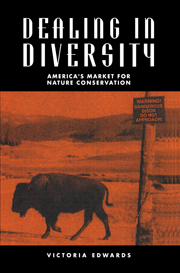Book contents
- Frontmatter
- Contents
- Preface
- Acknowledgments
- 1 Introduction: private provision of conservation
- 2 The conservation market
- 3 Collective action
- 4 Protection mechanisms and incentives
- 5 Fee-hunting
- 6 Watchable wildlife
- 7 Turning development into conservation
- 8 Conservation partners
- 9 Towards a more holistic approach
- References
- Index
1 - Introduction: private provision of conservation
Published online by Cambridge University Press: 19 January 2010
- Frontmatter
- Contents
- Preface
- Acknowledgments
- 1 Introduction: private provision of conservation
- 2 The conservation market
- 3 Collective action
- 4 Protection mechanisms and incentives
- 5 Fee-hunting
- 6 Watchable wildlife
- 7 Turning development into conservation
- 8 Conservation partners
- 9 Towards a more holistic approach
- References
- Index
Summary
There is a clear tendency in American conservation to relegate to government all necessary jobs that private landowners fail to perform.
Aldo Leopold (The Land Ethic)Background
When the North American continent was first settled in the sixteenth and seventeenth centuries, its land, undeveloped and rich in natural resources, supported a sparse population of some 12 million American Indians. The first colonists from England, who had left behind land scarcity and rising land prices, found a great contrast on the east coast of America:
the virgin American forests and their wildlife populations including white tailed deer, wild turkey, bobcats, cougars, ruffled grouse, black bear and wolves extended almost continuously from the East coast to the prairies of the Midwest. Salmon and shad migrated up the major Atlantic coastal rivers to spawn. The grassland prairies and plains stretching to the foothills of the Rocky Mountains were populated with unnumbered bison and prong-horned antelope, prairie birds, elk, mule deer, wolves, and grizzly bears. The lands beyond the Rockies to the Pacific coast were occupied by the crests of bare mountains at the higher elevations and deserts at the lowest. The lands between the deserts and the mountain tops were covered with evergeen forests and relatively dry grasslands. The great valley of central California was a vast plain and marshlands harboring elk, prong-horns, salmon, and grizzly bears. America was a land of natural beauty as well as abundant natural resources.
Council on Environmental Quality, 1984- Type
- Chapter
- Information
- Dealing in DiversityAmerica's Market for Nature Conservation, pp. 1 - 12Publisher: Cambridge University PressPrint publication year: 1995



